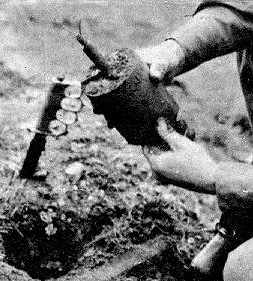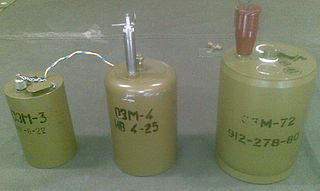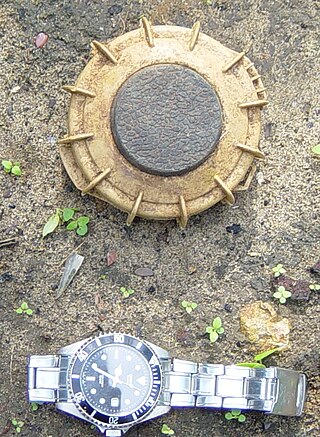
The Claymore mine is a directional anti-personnel mine developed for the United States Armed Forces. Its inventor, Norman MacLeod, named the mine after a large medieval Scottish sword. Unlike a conventional land mine, the Claymore may be command-detonated, and is directional, shooting a wide pattern of metal balls into a kill zone. The Claymore can also be activated by a booby-trap tripwire firing system for use in area denial operations.

The German S-mine, known by enemy Allied Forces as the "Bouncing Betty" on the Western Front and "frog-mine" on the Eastern Front, is the best-known version of a class of mines known as bounding mines. When triggered, these mines are launched into the air and then detonated at about one metre (3 ft) from the ground. The explosion projects a lethal spray of shrapnel in all directions. The S-mine was an anti-personnel mine developed by Germany in the 1930s and used extensively by German forces during World War II. It was designed to be used in open areas against unshielded infantry. Two versions were produced, designated by the year of their first production: the SMi-35 and SMi-44. There are only minor differences between the two models.

Valmara 69 or V-69 is an Italian bounding anti-personnel mine manufactured by Valsella. The mine was developed from the V-59 mine, and although the mine is no longer produced in Italy, a number of copies were produced in other countries e.g. the "SPM-1" manufactured by Singapore.

A bounding mine is an anti-personnel mine designed to be used in open areas. When it is tripped, a small propelling charge launches the body of the mine 3 to 4 feet into the air, where the main charge detonates and sprays fragmentation at roughly waist height.

The M16 mine is a United States-made bounding anti-personnel mine. It was based on captured plans of the World War II era German S-mine and has similar performance. The mine consists of a cast iron body in a thin steel sleeve. A central fuze well on the top of the mine is normally fitted with a pronged M605 pressure/tension (tripwire) fuze. Sufficient pressure on the prongs or tension on an attached tripwire causes the release of a striker. The freed striker is forced into a percussion cap which ignites a short pyrotechnic delay. The purpose of this delay is to allow the victim to move off the top of the mine, to prevent its upward movement from being blocked. Once the delay has burned through, a 4.5-gram black powder charge is ignited, which launches the inner iron body of the mine up into the air. The charge also ignites a second pair of pyrotechnic delays.

The PROM-1 is a Yugoslavian manufactured bounding anti-personnel mine. It consists of a cylindrical body with a pronged fuze inserted into the top of the mine. It is broadly similar in operation to the German S-mine.

The OZM-3, OZM-4 and OZM-72 are Soviet manufactured bounding type anti-personnel mines. (fragmentation-barrier mine, in the Russian and other post-Soviet armies as informally called "frog mine" or "witch" )

The PMN series of blast anti-personnel mines were designed and manufactured in the Soviet Union. They are one of the most widely used and commonly found devices during demining operations. They are sometimes nicknamed "black widow" because of their dark casings.

The VS-50 is a circular plastic-cased anti-personnel blast mine that entered production in 1985. It was formerly made by the now-defunct Valsella Meccanotecnica SpA, an Italian high-tech defence company specialized in area denial systems. The company also the made the Valmara 69, and was one of the first to implement plastic construction for landmines. The VS-50's design is similar to that of the TS-50 and VS-MK2 mines. It is blast resistant and can be used in a minimum metal configuration. Though unlikely to kill, its explosive charge is quite sufficient to destroy the victim's foot, being capable of penetrating 5 mm of mild steel leaving an 80 mm-diameter hole.
The M7 is a small, metal-cased United States anti-tank blast mine that was used during the Second World War. It was based on the British Hawkins grenade. Approximately 2.5 million were produced before production ceased, and although it has long since been withdrawn from U.S. service, it can be found in Angola, Burma, Cambodia, Chad, Eritrea, Ethiopia, Korea, Lebanon, Myanmar, Somalia, Thailand, and Zambia.

The M19 is a large square plastic cased United States anti-tank blast mine. Intended to replace the M15 mine, the design dates from the mid-1960s and contains only two metal components: the copper detonator capsule and a stainless steel firing pin which weighs 2.86 grams. It is a minimum metal mine, which makes it very difficult to detect after it has been emplaced. This mine is produced under licence in Chile, South Korea and Turkey. A copy is produced in Iran. It is found in Afghanistan, Angola, Chad, Chile, Cyprus, Iran, Iraq, Jordan, South Korea, Lebanon, the Western Sahara, and Zambia.

The VS-JAP is an Italian bounding anti-personnel mine. It is the latest of the Valmara family of bounding mines that includes the Valmara 59 and Valmara 69. The mine has a waterproof plastic faceted cylindrical body with a three-pronged cap, with a central fixing point for a tripwire. The fuze is triggered via downward or sideways pressure.
The NR-413 is a Belgian trip wire activated anti-personnel stake mine. The main body of the mine is wine bottle shaped, with an NR 410 tripwire fuse screwed into a fuse well on the top of the mine. Under the fuse well is a detonator and a row of booster pellets. Wrapped around the detonator and booster pellets is the main charge. An internally square cross-sectioned steel wire is coiled around the outside of the mine, which give a fragmentation effect. The mine produces 600 fragments with a velocity of approximately 1,660 metres per second. It has an effective range of around 15 metres. A variant is produced with a cast steel fragmentation jacket.
The MBV-78-A2 is a small cylindrical Vietnamese anti-personnel fragmentation stake mine. It is unrelated to the MBV-78-A1. The mine has a large plastic head which contains the main charge wrapped around the detonator. A fragmentation layer of steel pieces set into wax surrounds the main charge. The plastic head has two mounting lugs for stake mounting the mine. A Vietnamese copy of the Russian MUV fuze is typically used with the mine, although other fuzes could be used.

The M2 is a United States bounding anti-personnel mine used during World War II. A number of variants of the mine were produced and although the mine is no longer in US service, it can be found in Cyprus, Iran, Iraq, Korea, Laos, Oman, Rwanda, Tunisia and the Western Sahara. Copies of the mine were produced by Belgium, Pakistan (P7), Portugal (M/966) and Taiwan.

The Mle 1939 was a French anti-personnel bounding mine used at the start of the Second World War, it was developed largely in response to the German S-mine bounding mine. It saw very little service before the fall of France. The plans escaped to the US via Major Pierre Delalande, a member of the French Corps of Engineers, and were used as the basis for the American M2 bounding mine which saw wider service during the war but was considered largely ineffective. The M2 mine was replaced almost immediately afterwards with the M16 bounding mine, an almost exact copy of the German S-mine. The French also later produced a copy of the S-mine, the Mle 1951 mine.
The Mini MS-803 is a small South African produced Claymore type landmine. The design is very simple, with a convex brown polystyrene case containing a PE9 plastic explosive charge with three hundred 6 x 8 millimeter cylindrical steel fragments embedded into it. The mine is supported by two pairs of wire legs, which can be used to stack the mines. On the top of the mine is a small hole for inserting a detonator, which is surrounded with a PETN booster charge. The mine is normally used with an S4 electrical detonator connected to an M57 electrical firing device which is also used with the similar but larger Shrapnel mine Mk 2. The mine could also be used with MUV type pull detonators and tripwires, but after the Ottawa mine ban treaty South Africa has said that it will not use this mine with victim activated fuses.
The BM/85 is an Italian blast resistant bounding anti-personnel mine that was produced by Tecnovar italiana SpA. The mine is cylindrical with a three pronged tilt/pressure fuze on the top with a central post for attaching a tripwire. A plastic safety clip prevents the fuze from tilting when in transit. Once the pressure clip is removed the mine is armed. Once the fuze is pulled sideways by a trip wire or by downward pressure, the mine is triggered. A small charge launches the mine to a height of about 0.45 meters where it explodes scattering 1,000 fragments to a lethal radius of about 25 meters.
The M432 is a Portuguese bounding anti-personnel mine, which traces the roots of its design to the Second World War German S-mine, although it is probably more directly related to the Belgian NR 442 mine and United States M16 mine. As of 2004, all operational stocks of the mine have been destroyed, although some may have been retained for training purposes.

The AB 250-2(Abwurfbehälter) was a cluster bomb used by the Luftwaffe during World War II.














